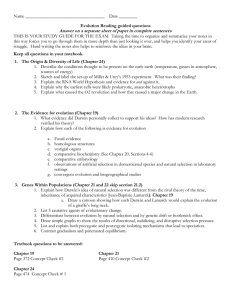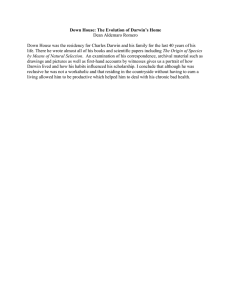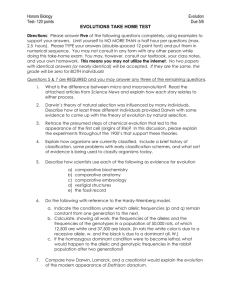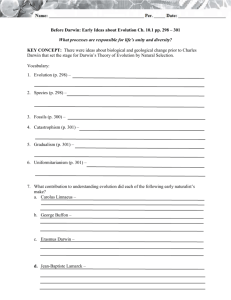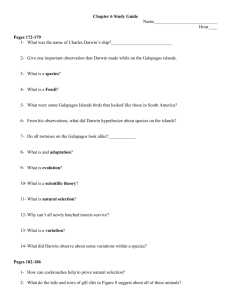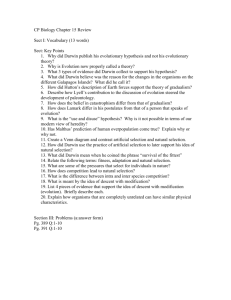WOODLAND HILLS SECONDARY LESSON PLAN STAGE I – DESIRED RESULTS Name
advertisement
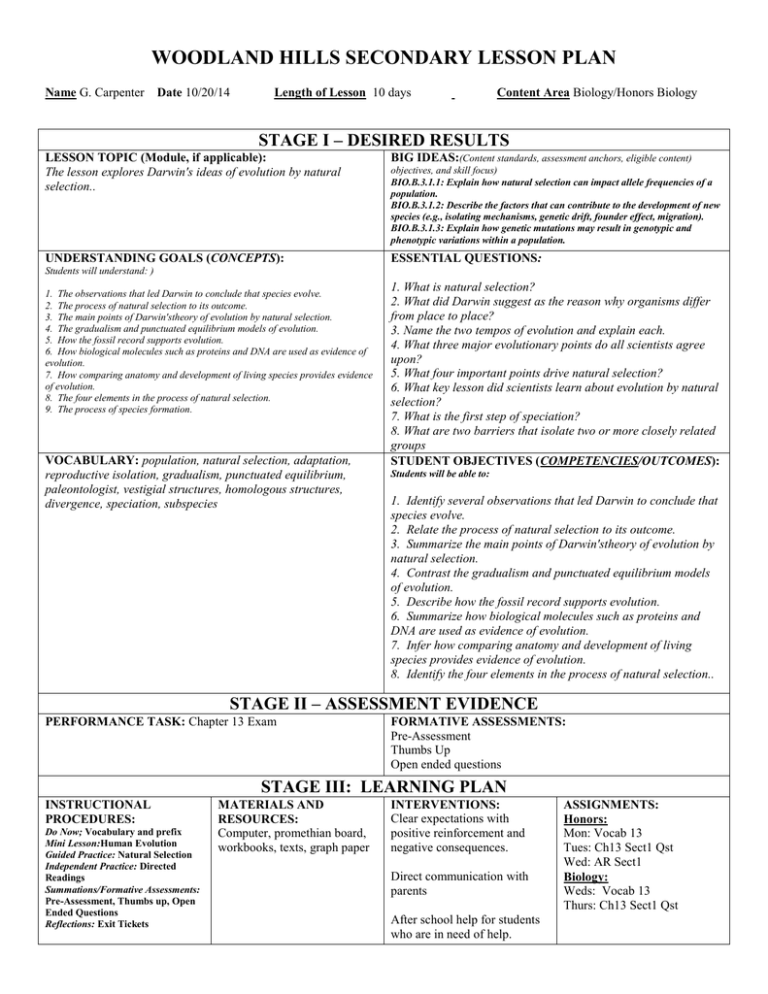
WOODLAND HILLS SECONDARY LESSON PLAN Name G. Carpenter Date 10/20/14 Length of Lesson 10 days Content Area Biology/Honors Biology STAGE I – DESIRED RESULTS LESSON TOPIC (Module, if applicable): The lesson explores Darwin's ideas of evolution by natural selection.. BIG IDEAS:(Content standards, assessment anchors, eligible content) UNDERSTANDING GOALS (CONCEPTS): ESSENTIAL QUESTIONS: objectives, and skill focus) BIO.B.3.1.1: Explain how natural selection can impact allele frequencies of a population. BIO.B.3.1.2: Describe the factors that can contribute to the development of new species (e.g., isolating mechanisms, genetic drift, founder effect, migration). BIO.B.3.1.3: Explain how genetic mutations may result in genotypic and phenotypic variations within a population. Students will understand: ) 1. The observations that led Darwin to conclude that species evolve. 2. The process of natural selection to its outcome. 3. The main points of Darwin'stheory of evolution by natural selection. 4. The gradualism and punctuated equilibrium models of evolution. 5. How the fossil record supports evolution. 6. How biological molecules such as proteins and DNA are used as evidence of evolution. 7. How comparing anatomy and development of living species provides evidence of evolution. 8. The four elements in the process of natural selection. 9. The process of species formation. VOCABULARY: population, natural selection, adaptation, reproductive isolation, gradualism, punctuated equilibrium, paleontologist, vestigial structures, homologous structures, divergence, speciation, subspecies 1. What is natural selection? 2. What did Darwin suggest as the reason why organisms differ from place to place? 3. Name the two tempos of evolution and explain each. 4. What three major evolutionary points do all scientists agree upon? 5. What four important points drive natural selection? 6. What key lesson did scientists learn about evolution by natural selection? 7. What is the first step of speciation? 8. What are two barriers that isolate two or more closely related groups STUDENT OBJECTIVES (COMPETENCIES/OUTCOMES): Students will be able to: 1. Identify several observations that led Darwin to conclude that species evolve. 2. Relate the process of natural selection to its outcome. 3. Summarize the main points of Darwin'stheory of evolution by natural selection. 4. Contrast the gradualism and punctuated equilibrium models of evolution. 5. Describe how the fossil record supports evolution. 6. Summarize how biological molecules such as proteins and DNA are used as evidence of evolution. 7. Infer how comparing anatomy and development of living species provides evidence of evolution. 8. Identify the four elements in the process of natural selection.. STAGE II – ASSESSMENT EVIDENCE PERFORMANCE TASK: Chapter 13 Exam FORMATIVE ASSESSMENTS: Pre-Assessment Thumbs Up Open ended questions STAGE III: LEARNING PLAN INSTRUCTIONAL PROCEDURES: Do Now; Vocabulary and prefix Mini Lesson:Human Evolution Guided Practice: Natural Selection Independent Practice: Directed Readings Summations/Formative Assessments: Pre-Assessment, Thumbs up, Open Ended Questions Reflections: Exit Tickets MATERIALS AND RESOURCES: Computer, promethian board, workbooks, texts, graph paper INTERVENTIONS: Clear expectations with positive reinforcement and negative consequences. Direct communication with parents After school help for students who are in need of help. ASSIGNMENTS: Honors: Mon: Vocab 13 Tues: Ch13 Sect1 Qst Wed: AR Sect1 Biology: Weds: Vocab 13 Thurs: Ch13 Sect1 Qst
